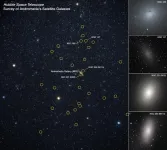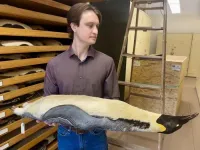(Press-News.org) The discovery of a powerful “weapon” used by many disease-causing fungi to infect and destroy major food crop staples, such as rice and corn, could offer new strategies to bolster global food security, according to researchers from The Australian National University (ANU) in collaboration with scientists in Germany and the United States.
Like humans, many fungi rely on plants as a food source. This impacts the yield of food crops. It’s estimated farmers lose between 10 to 23 per cent of their crops to fungal disease every year.
The global research team discovered that an enzyme known as a ‘NUDIX hydrolase’ is used by many fungal pathogens as a weapon to cause disease in plants. The findings are published in Science.
By uncovering the role this enzyme plays in infecting plants, the researchers believe they can engineer more resilient rice crops, as well as other fruit and vegetable crops, capable of safeguarding themselves against disease.
The findings could help bolster food security in nations where rice and corn are major commodities. According to the US Department of Agriculture, rice is the primary staple food for more than half of the world's population.
Lead author Dr Carl McCombe, who completed this work as part of his PhD at ANU, said the disease-causing enzyme can infiltrate plant cells and attack a key signalling molecule involved in the sensing of phosphate – a vital nutrient necessary for plant survival.
He said the enzyme “hijacks” key molecular pathways and tricks the plant into thinking it has a shortage of phosphate, activating a starvation-like response in the plant. This allows the pathogen to evade the immune system’s natural defence mechanisms and cause disease in the crop.
“In collaboration with colleagues at the Australian Nuclear Science and Technology Organisation, we were able to reveal the structure of the enzyme in detail using a technique called X-ray crystallography,” Dr McCombe, who is now a postdoctoral researcher at the California Institute of Technology (Caltech), said.
“Understanding what the enzyme looks like gave us critical insights into how it is used by pathogens to attack plants.”
Associate Professor Simon Williams, who led the ANU research team’s contribution to this work, said in addition to engineering new crops with a turbocharged immune system, the research findings could also help scientists uncover new ways to deactivate the “hijacking effect” of the enzyme, similar to turning it on and off like a light switch.
“Much of our work focused on the pathogenic fungus Magnaporthe oryzae, which causes rice blast disease. Rice is a critically important food staple, and losses from rice blast could feed 60 million people each year,” Associate Professor Williams said.
“Our research also reveals that the NUDIX hydrolase is used as a ‘weapon’ by many different fungi, including ones that are responsible for causing anthracnose disease in fruit, vegetable and seed crops. These diseases impact crop production in foods such as mangoes, melons, corn and chickpeas – produce that Australians enjoy daily.
“This suggests our work also has implications to safeguard other important fruit and vegetable staples.”
Associate Professor Williams said the findings offer a roadmap to develop new disease management strategies.
“This could involve engineering the plant’s immune system to detect the enzyme or block its function. This could help farmers protect their crops and secure global food supplies,” he said.
This work involved scientists from ANU, RWTH Aachen University and Louisiana State University.
Images available to download here.
Photo credit: Jamie Kidston/ANU
END
Discovery of a common ‘weapon’ used by disease-causing fungi could help engineer more resilient food crops
2025-02-27
ELSE PRESS RELEASES FROM THIS DATE:
University of Oklahoma researcher to create new coding language, computing infrastructure
2025-02-27
NORMAN, OKLA. – In an increasingly data-saturated world, computing infrastructure innovations are needed to make sense of new types of information. Richard Veras, a professor in the School of Computer Science at the University of Oklahoma, has received a National Science Foundation Faculty Early Career Development Program (CAREER) award to develop such an innovation by creating more efficient infrastructure for the computation of sparse and irregular data.
Big data – datasets that are challenging to manage using traditional processing tools due to size and complexity, such as social ...
NASA’s Hubble provides bird’s-eye view of Andromeda galaxy’s ecosystem
2025-02-27
Located 2.5 million light-years away, the majestic Andromeda galaxy appears to the naked eye as a faint, spindle-shaped object roughly the angular size of the full Moon. What backyard observers don't see is a swarm of nearly three dozen small satellite galaxies circling the Andromeda galaxy, like bees around a hive.
These satellite galaxies represent a rambunctious galactic "ecosystem" that NASA's Hubble Space Telescope is studying in unprecedented detail. This ambitious Hubble Treasury Program used observations from more than a whopping 1,000 Hubble orbits. Hubble's optical stability, clarity, and efficiency ...
New ocelot chip makes strides in quantum computing
2025-02-27
Scientists based at the AWS Center for Quantum Computing on Caltech's campus have made a leap forward in figuring out how to suppress errors in quantum computers, a pesky problem that continues to be the greatest hurdle to building the machines of the future.
Quantum computers, which are based on the seemingly magical properties of the quantum realm, hold promise for use in many different fields, including medicine, materials science, cryptography, and fundamental physics. But while today's quantum computers can be useful for ...
Computing leaders propose measures to combat tech-facilitated intimate partner violence, human trafficking, and child exploitation
2025-02-27
The Association for Computing Machinery’s Technology Policy Council (TPC) has announced the publication of “TechBrief: Technology Policy Can Curb Domestic Violence, Human Trafficking, and Crimes Against Children,” a new issue brief which explains how intimate partner violence, human trafficking, and child exploitation are facilitated by computing technologies. The term “tech abuse” pertains to a wide variety of abuse in this context. The ACM policy experts contend that tech abuse is being addressed inconsistently, ...
Sometimes, when competitors collaborate, everybody wins
2025-02-27
CAMBRIDGE, MA – One large metropolis might have several different train systems, from local intercity lines to commuter trains to longer regional lines.
When designing a system of train tracks, stations, and schedules in this network, should rail operators assume each entity operates independently, seeking only to maximize its own revenue? Or that they fully cooperate all the time with a joint plan, putting their own interest aside?
In the real world, neither assumption is very realistic.
Researchers from MIT and ETH Zurich have developed a new planning ...
EU Flagship project DORIAN GRAY to use pioneering AI and avatar technology to uncover links between cardiovascular disease (CVD) and mild cognitive impairment (MCI) to improve healthy ageing and survi
2025-02-27
Key take-aways:
Mild cognitive impairment (MCI) is a stage of decline in cognitive function greater than normal for a person’s age and education, not severe enough to impair daily function – but it can progress.
Around one third of people with cardiovascular disease (CVD) also have MCI, yet MCI is undiagnosed in 50-80% of these cases.
The central aim of the EU’s DORIAN GRAY project is to untangle this MCI-CVD connection, reduce the burden of disease at older ages and prolong survival.
Brescia, Italy – 27 February 2025 – A major new project, DORIAN GRAY, ...
SHEA encourages rescheduling postponed Advisory Committee on Immunization Practices (ACIP) Meeting
2025-02-27
The Advisory Committee on Immunization Practices (ACIP) plays a crucial role in protecting childhood and adult health by developing vaccination recommendations based on scientific evidence. SHEA encourages timely rescheduling of the ACIP’s meeting that was scheduled for February 2025 to ensure patients and healthcare providers are getting the most up to date recommendations based on the latest scientific evidence review regarding vaccination.
The ACIP’s recommendations are foundational to public health, guiding pediatric and adult vaccine schedules that have significantly reduced the prevalence of highly communicable infectious ...
Study proposes a new theoretical framework for understanding complex higher-order networks
2025-02-27
Filippo Radicchi, professor of Informatics at the Luddy School of Informatics, Computing, and Engineering, co-authored a ground-breaking study that could lead to the development of new AI algorithms and new ways to study brain function.
The study, titled “Topology shapes dynamics of higher-order networks,” and published in Nature Physics, proposed a theoretical framework specifically designed for understanding complex higher-order networks. It could lead to breakthroughs ...
Archaeology: Vesuvian ash cloud turned brain to glass
2025-02-27
A unique dark-coloured organic glass, found inside the skull of an individual who died in Herculaneum during the 79 CE Mount Vesuvius eruption, likely formed when they were killed by a very hot but short-lived ash cloud. The conclusion, from research published in Scientific Reports, is based on an analysis of the physical properties of the glass, thought to comprise the fossilised brain of the individual.
Glass rarely occurs naturally due to the specific conditions required for formation. For a substance to become glass, its liquid form must cool fast ...
When birds lose the ability to fly, their bodies change faster than their feathers
2025-02-27
More than 99% of birds can fly. But that still leaves many species that evolved to be flightless, including penguins, ostriches, and kiwi birds. In a new study in the journal Evolution, researchers compared the feathers and bodies of different species of flightless birds and their closest relatives who can still fly. They were able to determine which features change first when birds evolve to be flightless, versus which traits take more time for evolution to alter. These findings help shed light on the evolution of complex traits that lose their original ...





